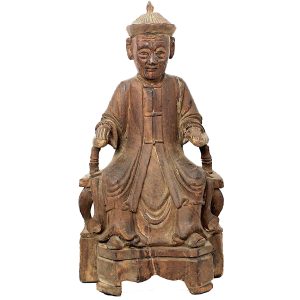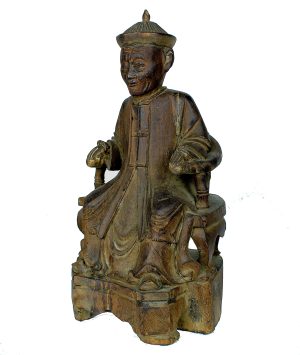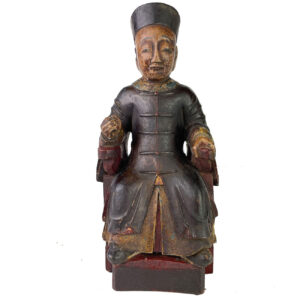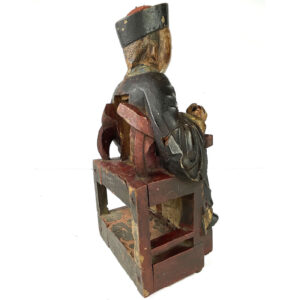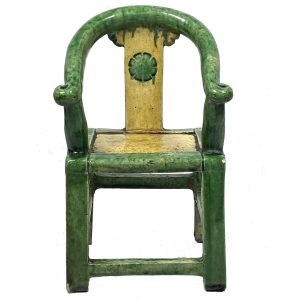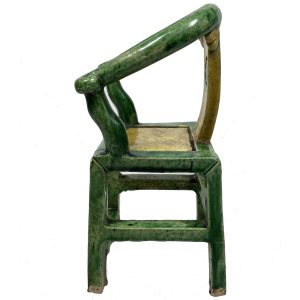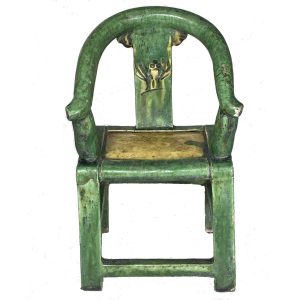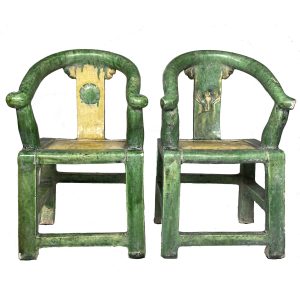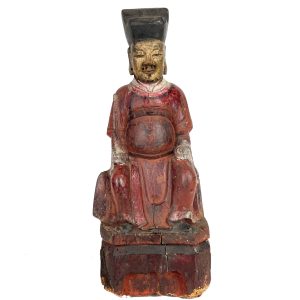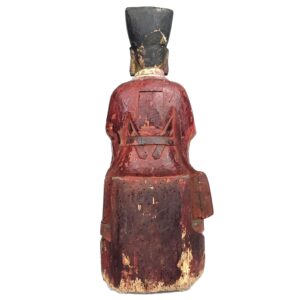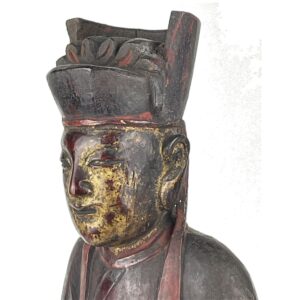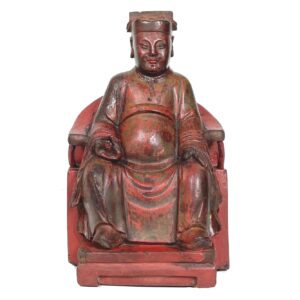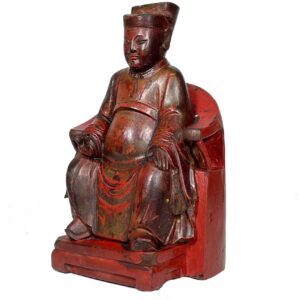-
Sale!


$2,285.00 Original price was: $2,285.00.$1,700.00Current price is: $1,700.00.
H: 34″ W: 11.25″ D: 7.25″ | CALL 213-568-3030 OR EMAIL [email protected] FOR SHIPPING
Although this wonderfully carved antique figure portrays an ancestor depicted as an official, his atypically benevolent and finely modeled face makes him a very endearing figure. Old and weathering from age in its rear, this piece was repainted probably in the 20th century, as was periodically done with old figures with losses, especially due to seasonal South China climate. With his individualized convincing features, he is a very relatable rather than authoritarian figure, possibly resulting from the affection of the family that commissioned it. This beautiful and vibrant carving would enhance any setting.
-
Sale!


$4,950.00 Original price was: $4,950.00.$4,200.00Current price is: $4,200.00.
H: 23.5″ W: 15.625″ D: 10″ |CALL 213-568-3030 OR EMAIL [email protected] FOR SHIPPING COST
This exceptional Qing carving portrays a seated official ancestor wearing traditional official’s attire, a red and black official’s hat and black boots. His inset glass eyes and high cheekbones frame a large curved nose, a strong projecting chin and forehead wrinkles indicating a man of importance with the wisdom of age who demands respect. The top two robe layers have wide borders with marvelous raised lacquer decorations that include beautiful cloud forms, flying phoenixes with spread wings and floral sprays.
-
Sale!


$425.00 Original price was: $425.00.$250.00Current price is: $250.00.
Ht: 8.25″ W: 3″ D: 2.125″ | FREE SHIPPING IN CONTINENTAL US!
Dressed in a red robe with a high neck collar, extremely wide sleeves extending below the knees and a belt around his waist, this ancestor figure portrayed as a civilian official standing on a rectangular base with hands together wearing a long civil official’s robe that extends to his shoes but has no rank badge indicated.
-
Sale!


$850.00 Original price was: $850.00.$695.00Current price is: $695.00.
H: 12.75” W: 6.625” D: 5.75” | FREE SHIPPING within Continental u.s.
This masterfully carved ancestor as a mandarin official sits on horseshoe chair set on a footed high decorated plinth dressed in a well-appointed formal 3-button Mandarin long coat and pointed rattan hat. His face is uniquely and unusually individualized with heavy lidded eyes, in a benevolent expression and his advanced aged indicated by the wrinkles clearly depicting a loved individual. This exquisitely carved image in excellent condition with a fine patina was true homage to a revered family member and is one of our finest ancestor figures.
-
Sale!


$455.00 Original price was: $455.00.$295.00Current price is: $295.00.
H:8.5 ” W: 4 ” D: 3.3 ” | FREE SHIPPING WITHIN CONTINENTAL U.S.!
Portrayed as an official, this ancestor figure sits on a horseshoe chair showing his status wearing compulsory officials attire: a 5-button Mandarin long coat with a round collar and official headwear – a woven hat whose shape and color reflected his rank. His personalized personalized oval-shaped is tranquil with a hint of a smile on his pursed lips, and a triangular pigtail down his back.
-


$395.00
In China a set of earthenware Zodiac attendant figures was made as a 12 piece grouping, with each figure holding a small calendar animal with each year represented by a different animal – rat, ox, tiger, rabbit, dragon, snake, horse, goat, monkey, rooster, dog, and pig or boar – in a repeating 12-year cycle. Although…
-
Sale!


$685.00 Original price was: $685.00.$395.00Current price is: $395.00.
H: 7.375″ W: 4.375″ D: 3.75″ | FREE SHIPPING WITHIN CONTINENTAL U.S.!
Horseshoe chairs were considered a sign of rank used by officials and often ancestral figures were portrayed sitting in them to reflect their high status. This well-modeled green glaze ceramic mingqi of a horseshoe chair is decorated with a yellow glaze imitating caning and the decorative carved circular design on the splat. It pairs perfectly with Ming Dynasty Earthenware Horseshoe Chair 3330 and together would add to a fine collection of miniature Chinese ceramics.
-
Sale!


$685.00 Original price was: $685.00.$395.00Current price is: $395.00.
H: 7.375″ W: 4.375″ D: 3.75″ | FREE SHIPPING WITHIN CONTINENTAL U.S.!
Horseshoe chairs were considered a sign of rank used by officials and often ancestral figures were portrayed sitting in them to reflect their high status. This well-modeled green glaze ceramic mingqi of a horseshoe chair is decorated with a yellow glaze imitating caning and the decorative carved circular design on the splat. It pairs well with item Ming Earthenware Horseshoe Chair 3331. This would be a fine addition to a collection of antique ceramics or simply a beautiful decorative piece to brighten a small space.
-
Sale!


$875.00 Original price was: $875.00.$475.00Current price is: $475.00.
H: 15.5″ W: 6.125 ” 4.125 D: ” | FREE SHIPPING WITHIN CONTINENTAL U.S.!
This carved ancestor figure portrayed as an official sits on a backless chair with a decorative pedestal in official’s attire: a high collared red robe, double belt above and below his ample stomach and holding a long slender curved hu-tablet, all signs of his office and status. He is vibrantly painted in red, the color of fu, as a wish for prosperity and status.
-


$985.00
H: 15″ W: 6.5″ D: 5.5″ | EMAIL [email protected] OR CALL 213-568-3030 FOR SHIPPING COST
This excellently carved civilian official with gilt highlights was commissioned by a family to place on a home altar for veneration and to impress those who viewed it. The imposing ancestor figure grasps his belt of office to show his pride in passing examinations to become a civil official, which leads to a life of rank and prosperity for him and his family. Statues like this are an affirmation of persistence, success, status and power and they honor those who display these characteristics.
-
Sale!


$650.00 Original price was: $650.00.$325.00Current price is: $325.00.
H: 7.25” W: 4.625” D: 3.5” | FREE SHIPPING WITHIN CONTINENTAL U.S.
Finely carved ancestor displaying status symbols: official’s attire and hat, horseshoe chair with feet on pedestal Masterfully carved and lacquered and is painted on front and back in red with traces of gilt – all propitious colors of “fu” as a wish for wealth, health, good fortune, long life and long life – that has faded over it years of use into a great patina.
-
Sale!


$450.00 Original price was: $450.00.$395.00Current price is: $395.00.
Ht: 9″ W: 5″ D: 3.5″ | FREE SHIPPING WITHIN CONTINENTAL U.S.!
During the Ming and Qing dynasties small images of Taoist officials and priests were often shown holding a cup of the elixir of life to place on home altars along with ancestor figures, house gods and other religious images to bring blessings (fu) to the household. By commissioning figures like this artful carving, families honored their ancestors and met their filial piety duties. Mounted on an acrylic stand.
End of content
End of content







